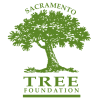Chronicles of the Sacramento elms: Part 2
by Chris Fenstermaker, Volunteer
April 27, 2016

As National Arbor Day approaches on April 29, it’s a good time to reflect on our region’s devotion to the trees that make our landscape so pleasing to the senses. Until the 1880s, Sacramento was nicknamed the City of Plains for its broad, treeless flatlands. It was then that an effort began to transform the area into the City of Trees; the elm was the crown jewel of the new canopy. Besides its full canopy and great heights that shade our streets, the elm was also favored for its ability to deal with cramped locations and pollution. Sacramento, one of the sunniest spots in the U.S., benefits tremendously from these shade champions.

As we mentioned last month, Sacramento’s elm population has been under attack for quite some time. Damage began in the 1940s when many young and middle-aged elms were hit by severe windstorms and then further affected by poor topping and pruning practices. Budget cuts reduced tree care in the decades beyond. More recently, the elm leaf beetle and Dutch elm disease (DED) have continued the downward spiral, starting in earnest in Sacramento in the 1990s.

Elm leaf beetles eat elm leaves, weakening the tree, but not killing it. DED is more serious – a deadly threat without a cure. DED is spread by a different beetle, the European elm bark beetle, which sometimes carries the DED fungus on its feet. It may also be spread by underground root-to-root contact from an infected tree. DED is a vascular disease that travels downward to the tree’s roots, and then upward throughout the canopy. Symptoms include wilting, yellowing, and/or browning of leaves (called flagging) as well as a discoloration of sapwood. Once DED is established in a tree, it is fatal due to the aggressive nature of the disease. Consecutive droughts have only increased the misery.

Every spring, the Sacramento Tree Foundation and the City of Sacramento recruit and train community scientists to help monitor the remaining public elms for signs of DED. Trees identified with potential DED symptoms will be examined by city arborists to determine if the disease is present; diseased trees will be removed promptly in an attempt to wipe out the fungal source. Your involvement is crucial in preserving our stately elm canopy! Learn more about the Save the Elms Program or mark your calendars for spring when training dates will be announced.
